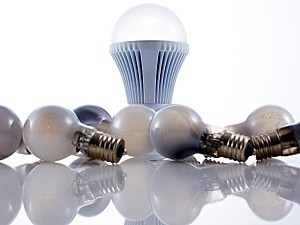If you've ever curiously browsed for LED bulbs, you may have noticed a whole new nomenclature and jargon - none of it recognizable, none of it helping you figure out how bright the damn the bulb is.
I'll explain how to decipher packaging and how LED makers are beginning to deliver incandescent's soft white lighting.
Incandescent equivalency
All electrical lighting draws power (duh). Typical incandescent or compact fluorescent light (CFL) bulbs equate this power draw, expressed in watts, with the amount of light given off.
LED lighting doesn't work this way.
An LED fixture draws a quarter of the power as an incandescent or CFL. Or, put another way, an incandescent or CFL requires four times as much power to provide the same amount of light as an LED.
Therefore, the power an LED bulb draws does not equal its brightness.
So, LED brightness is expressed in lumens (based on candlepower, or candela).
A 60-watt incandescent or CFL shines at 800 lumens, which is the figure you'll usually see on 60-watt equivalent LED bulbs. A 100-watt LED bulb (which I'll get to in a minute) shines at around 1600 lumens (I have no idea if there's a formula to convert watts to lumens - and I don't want to know).
It's nothing you have to worry about at the moment. Most LED bulb makers indicate the incandescent equivalent and lumens on their packaging. Check up this handy lumens page (which includes an explanatory lumens video) on this Energy Savers Web page from the U.S. Department of Energy.
So get used to thinking about light brightness in lumens, not watts.
Philips, however, insists on referring uselessly to their bulbs by watts. For instance, the 100-watt equivalent we linked to yesterday is called the EnduraLED 23-watt. And you're supposed to know how bright a 23-watt LED is?
If you're shopping for Philips LED bulbs - or any LED that lists an unfamiliar low wattage, just multiple the listed wattage by four to get the approximate incandescent equivalent.
Finally, all bulb sizes are identified by an alphanumeric nomenclature. For instance, the standard lamp bulb size of any lighting technology is referred to as an A19. So, if you're looking at an odd-shaped LED bulb and you're wondering if it's a true standard incandescent replacement, just look for "A19" in its description or specs.
Quality of light
One lingering issue when comparing LEDs to incandescent (as well as CFLs to incandescents) is not the power, but the quality of light - particularly the familiar incandescent "soft white" light.
The biggest complaint among early LED and especially CFL buyers was that their glow didn't seem "right" - it was greyish or bluish, or sharp and harsh, rather than emitting the comforting soft, warm glow of incandescents.
For LEDs, this unnatural light situation is changing, albeit slowly.
This is probably more than you need to know, but visible light has color, expressed as temperature, measured in Kelvins (named for Lord Kelvin).
For LED bulbs, there is "cool" light, which tends more toward a bluish hue that many complain about, and "soft" or "warm" color temperature, which usually radiates a more reddish or yellowish hue.
You'll find "color temperature" buried in the picture settings of your HDTV. If you toggle between them, you'll see what I mean about bluish or reddish hue.
"Cool" is LED's natural state. Getting a LED bulb to glow "warm" or "soft" is a bit harder and reduces the efficiency of the bulb, according to Tom Simpson, LED lab manager at 3M, which just unveiled it's own "soft white" 60-equivalent LED bulb.
A technical explanation
I'll let Tom the 3M lab guy explain further:
LEDs that emit blue light are more efficient than those that emit at green or red, so we start with blue light. The yellow appearance that is visible over the top of most white LEDs is caused by phosphors. Phosphors absorb some of the blue light, then re-emit at longer wavelengths to generate the green and red light, that together with the blue light, comprise white light.
Phosphor technology is generally well-known, but making the conversion happen in the most efficient manner possible is an ongoing challenge. In general, converting more of the blue light will deliver a warmer color of light.
The processes that converts the color of the light are not 100 percent efficient, so equivalent light output from a warmer package requires more light to be generated by the LED, which translates to more expense and lower efficiency. Add to that the cost of the phosphors, which are not cheap, and all things being equal, it is more expensive to generate warmer light than it is to generate cooler light.
In other words, incandescent-like "warm" or "soft" LED bulbs are harder to do, and therefore rarer, and may cost a bit more than their cooler light LED siblings.

Related:
All About LED, Part 1: Bulb Basics
All About LED Bulbs, Part 3: The Dimming Dilemma
LED Bulbs, Part 4: Save Money, Save the Planet





